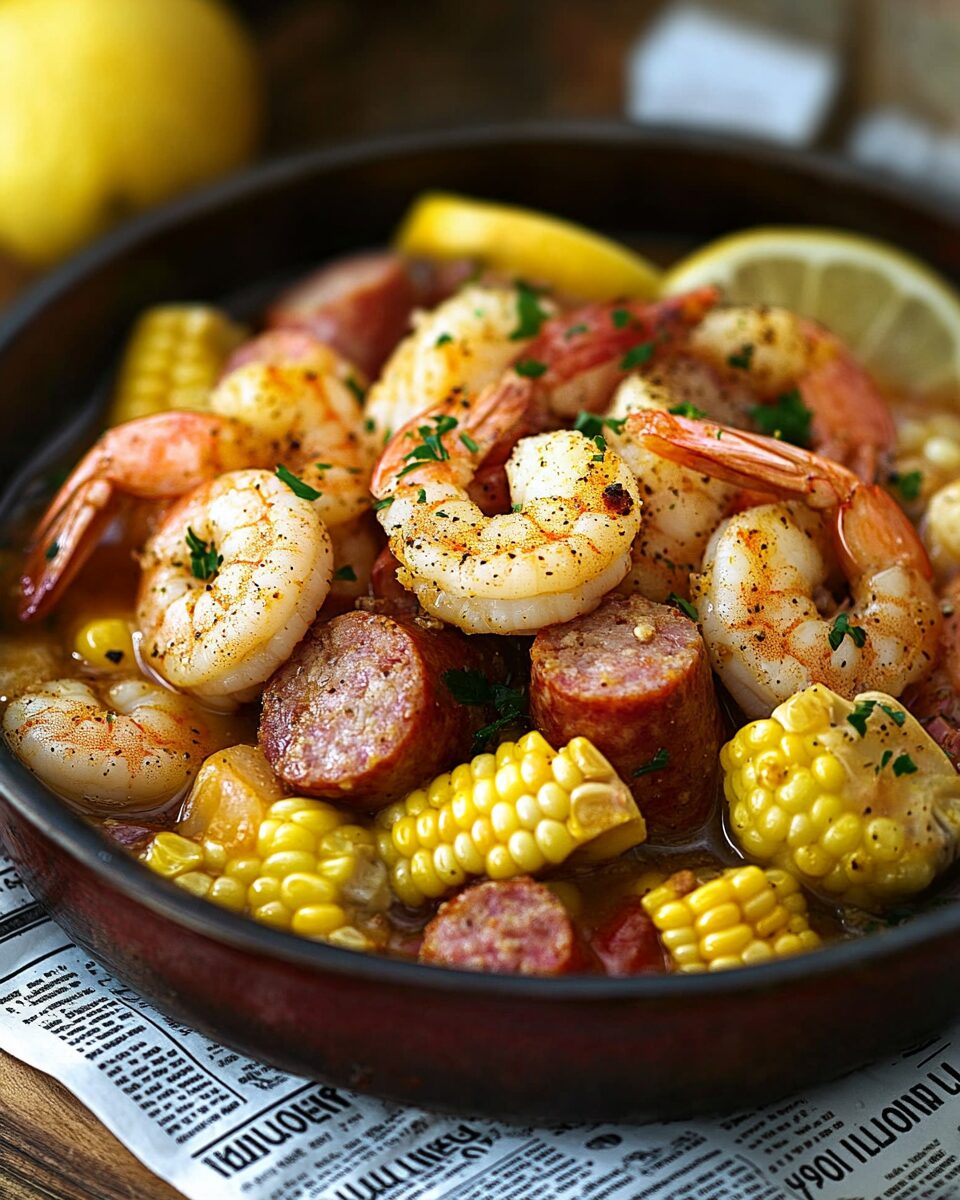The magic of Frogmore Stew lies in its simplicity and rich cultural roots. Originating from the coastal region of South Carolina, this dish also known as a Lowcountry Boil celebrates local seafood and seasonal produce in the most heartwarming way. With shrimp, sausage, potatoes, and corn boiled in a spiced broth, it’s a feast that brings communities together, traditionally enjoyed outdoors with loved ones. Perfect for gatherings or summer evenings, Frogmore Stew is less about precision and more about enjoyment. It’s served casually, often dumped out onto a paper-covered table for everyone to dig in. This rustic dish is a reminder that great food doesn’t have to be fancy it just has to be flavorful and made with love. Whether you’re hosting a backyard boil or simply craving Southern comfort, Frogmore Stew is the kind of meal that turns a dinner into an experience.
Full Recipe:
Ingredients:
-
1 lb shrimp (shell-on, deveined)
-
1 lb smoked sausage, sliced into 1-inch pieces
-
4 ears of corn, cut into thirds
-
1 lb baby potatoes
-
1 large onion, quartered
-
4 garlic cloves, smashed
-
1 lemon, halved
-
4 tbsp Old Bay seasoning
-
Salt to taste
-
Water
-
Optional: hot sauce, butter, fresh parsley
Directions:
-
Fill a large stockpot halfway with water. Add Old Bay seasoning, onion, garlic, lemon halves, and salt. Bring to a rolling boil.
-
Add the potatoes and cook for 10-12 minutes, or until just tender.
-
Toss in the sausage and cook for another 5 minutes.
-
Add corn and cook for 5-7 more minutes.
-
Finally, add shrimp and cook just until pink and opaque about 3 minutes.
-
Drain the stew and serve it hot on a newspaper-lined table or large tray. Garnish with parsley and lemon wedges if desired. Optional melted butter or hot sauce on the side.
Prep Time: 15 minutes | Cooking Time: 25 minutes | Total Time: 40 minutes
Kcal: 390 kcal | Servings: 6 servings
A Beloved Southern Classic for Every Gathering
Frogmore Stew, also popularly known as a Lowcountry Boil, is one of the most iconic Southern dishes, celebrated for its simplicity, flavor, and communal spirit. Despite the name, it contains no frogs. Instead, it’s a robust seafood boil that typically features shrimp, sausage, corn on the cob, and potatoes all simmered together in a well-seasoned broth. Hailing from the Sea Islands of South Carolina, specifically the town of Frogmore on St. Helena Island, this dish has grown in popularity across the American South and beyond.
Frogmore Stew isn’t just a recipe it’s an experience. This dish is typically made in large batches and served at gatherings, often poured out over a newspaper-covered table for a fun, hands-on, no-fuss feast. It’s a cultural staple for family reunions, backyard parties, and coastal celebrations, blending history, hospitality, and hearty flavors into one pot.
The Cultural Roots of Frogmore Stew
This dish has deep roots in Gullah-Geechee culture, where the blending of African, Caribbean, and Southern influences helped shape what we now consider traditional Lowcountry cuisine. Frogmore Stew reflects the resourceful cooking style of using local ingredients such as fresh Atlantic shrimp, smoked sausage, seasonal corn, and new potatoes.
Over the years, Frogmore Stew evolved from being a regional delicacy to a well-loved Southern tradition. It’s known for its communal dining style, often enjoyed outdoors during the summer months. The casual setup of laying everything out on a table allows everyone to dig in together, creating a vibrant social dining atmosphere that is rare in many modern mealtime settings.
Why It’s Called “Frogmore” Stew
The name “Frogmore” comes from a small community on St. Helena Island in South Carolina. Though the town no longer has an official post office, its name lives on through this famous dish. Some people refer to it as Lowcountry Boil or Beaufort Boil to avoid confusion, especially outside of South Carolina. Regardless of the name, the recipe remains consistent a flavorful one-pot meal that feeds many and brings people together.
What Makes Frogmore Stew Unique?
One of the most unique aspects of Frogmore Stew is its versatility and adaptability. While the classic version consists of shrimp, sausage, corn, and potatoes, many cooks add their own twist. Some may include crab legs, clams, or even lobster, while others experiment with different types of sausage or spice blends. The heart of the dish remains the same: simple ingredients cooked in a flavorful broth, served with minimal utensils, and meant to be shared.
Another defining characteristic is the heavy use of seasoning especially Old Bay seasoning, a blend of spices that gives the dish its signature zesty and slightly spicy flavor. The lemon halves, garlic, and onions simmering in the broth enhance the depth of flavor, making every bite of the stew taste like the coastal breeze.
The Social Element: Why Frogmore Stew is a Party Favorite
Unlike most plated meals, Frogmore Stew invites guests to eat communally and casually. It’s a meal that encourages interaction, laughter, and storytelling. The shared experience of eating with your hands, reaching across the table, and peeling shrimp side by side with friends or family builds a unique camaraderie. That’s why this dish is often found at events such as:
-
Backyard BBQs
-
Summer seafood boils
-
Family reunions
-
Holiday weekends
-
Community potlucks
The ease of preparation also makes it ideal for large groups. All the ingredients cook in the same pot, and cleanup is minimal especially if served on paper-covered tables. Add some cold drinks, music, and sunshine, and you’ve got yourself the perfect Southern gathering.
Regional Variations and Modern Twists
As with many traditional dishes, Frogmore Stew has inspired countless variations depending on the cook’s creativity or the availability of ingredients. In Louisiana, for example, you might find a version closer to a Cajun-style seafood boil, featuring crawfish, spicier sausage, and heavier use of cayenne pepper.
Vegetarian versions are becoming more popular too, substituting shrimp and sausage with plant-based alternatives and ramping up the use of vegetables like mushrooms, artichokes, or okra. Health-conscious cooks sometimes use turkey sausage or leaner meats, while adventurous chefs might add beer to the cooking liquid for an added depth of flavor.
What’s great is that this dish allows for such personalization without losing its essence. Whether you stick to tradition or add your own flair, the result is always a bold, satisfying meal.
Pairing Suggestions
While Frogmore Stew can stand on its own, it pairs wonderfully with several Southern sides and beverages. Here are a few ideas to round out your meal:
Side Dishes:
-
Coleslaw with vinegar dressing
-
Buttermilk cornbread or hush puppies
-
Pickled vegetables or cucumbers
-
Deviled eggs
-
Fresh watermelon slices
Drinks:
-
Sweet tea
-
Lemonade
-
Light beer or hard seltzer
-
White wine with citrus notes
Adding a homemade dipping sauce like garlic butter or a spicy remoulade can also elevate the experience.
Tips for Making the Best Frogmore Stew
To ensure your Frogmore Stew is a hit every time, here are some tried-and-true tips:
-
Use fresh, shell-on shrimp: Shell-on shrimp add more flavor to the broth and stay juicier. Just make sure they’re deveined.
-
Stagger your cooking times: Potatoes take longer than shrimp, so follow a specific order to ensure everything is cooked perfectly and nothing gets overdone.
-
Don’t skimp on seasoning: The flavor of the broth infuses everything in the pot, so be generous with the Old Bay and aromatics.
-
Serve immediately: This dish is best enjoyed hot and fresh. Have your table set and guests ready before draining the pot.
-
Provide napkins and finger bowls: Since this is a hands-on meal, it’s good hospitality to offer guests a way to clean up easily.
Environmental and Ethical Considerations
In today’s climate-conscious world, it’s worth noting that Frogmore Stew can be made sustainably. Choose wild-caught or sustainably farmed shrimp when possible, and support local farmers for your corn and potatoes. Using recyclable or compostable materials for serving helps keep the environmental footprint minimal, especially at large outdoor events.
Conclusion:
Frogmore Stew is more than just a dish it’s a celebration of Southern hospitality, local ingredients, and togetherness. It embodies everything that makes regional cooking so powerful: the connection to land and sea, the history of its people, and the joy of sharing food with others.
Whether you’re cooking for family, friends, or a crowd, Frogmore Stew offers a flavorful, no-fuss way to bring everyone together. With its simple ingredients, robust flavor, and engaging presentation, it’s no surprise this dish continues to be a favorite across generations and state lines. Once you’ve experienced a true Lowcountry boil, it’s hard not to fall in love with its charm and comfort.

